Connect to and manage Azure Data Explorer in Microsoft Purview
This article outlines how to register Azure Data Explorer, and how to authenticate and interact with Azure Data Explorer in Microsoft Purview. For more information about Microsoft Purview, read the introductory article.
Supported capabilities
| Metadata Extraction | Full Scan | Incremental Scan | Scoped Scan | Classification | Labeling | Access Policy | Lineage | Data Sharing | Live view |
|---|---|---|---|---|---|---|---|---|---|
| Yes | Yes | Yes | Yes | Yes | Yes | No | Limited* | No | No |
* Lineage is supported if dataset is used as a sink in Data Factory or Synapse pipeline.
Prerequisites
An Azure account with an active subscription. Create an account for free.
An active Microsoft Purview account.
You will need to be a Data Source Administrator and Data Reader to register a source and manage it in the Microsoft Purview governance portal. See our Microsoft Purview Permissions page for details.
Register
This section describes how to register Azure Data Explorer in Microsoft Purview using the Microsoft Purview governance portal.
Authentication for registration
There are several methods available for authentication for Azure Data Explorer:
Service Principal to register
To use service principal authentication for scans, you can use an existing one or create a new one.
Note
If you have to create a new Service Principal, please follow these steps:
- Navigate to the Azure portal.
- Select Microsoft Entra ID from the left-hand side menu.
- Select App registrations.
- Select + New application registration.
- Enter a name for the application (the service principal name).
- Select Accounts in this organizational directory only.
- For Redirect URI select Web and enter any URL you want; it doesn't have to be real or work.
- Then select Register.
It is required to get the Service Principal's application ID and secret:
- Navigate to your Service Principal in the Azure portal
- Copy the values the Application (client) ID from Overview and Client secret from Certificates & secrets.
- Navigate to your key vault
- Select Settings > Secrets
- Select + Generate/Import and enter the Name of your choice and Value as the Client secret from your Service Principal
- Select Create to complete
- If your key vault is not connected to Microsoft Purview yet, you will need to create a new key vault connection
- Finally, create a new credential using the Service Principal to set up your scan
Granting the Service Principal access to your Azure data explorer instance
Navigate to the Azure portal. Then navigate to your Azure data explorer instance.
Add the service principal to the AllDatabasesViewer role in the Permissions tab.
System or user assigned managed identity to register
System-assigned managed identity - As soon as the Microsoft Purview Account is created, a system-assigned managed identity (SAMI) is created automatically in Microsoft Entra tenant. It has the same name as your Microsoft Purview account.
User-assigned managed identity (preview) - Similar to a system-managed identity, a user-assigned managed identity (UAMI) is a credential resource that can be used to allow Microsoft Purview to authenticate against Microsoft Entra ID. For more information, you can see our User-assigned managed identity guide.
To register using either of these managed identities, follow these steps:
If you would like to use a user-assigned managed identity and have not created one, follow the steps to create the identity in the User-assigned managed identity guide.
Navigate to the Azure portal. Then navigate to your Azure data explorer instance.
Select the Permissions tab on the left pane.
Add the SAMI or UAMI to the AllDatabasesViewer role in the Permissions tab.
Steps to register
To register a new Azure Data Explorer (Kusto) account in your data catalog, follow these steps:
Open the Microsoft Purview governance portal by:
- Browsing directly to https://web.purview.azure.com and selecting your Microsoft Purview account.
- Opening the Azure portal, searching for and selecting the Microsoft Purview account. Selecting the the Microsoft Purview governance portal button.
Select Data Map on the left navigation.
Select Register
On Register sources, select Azure Data Explorer
Select Continue
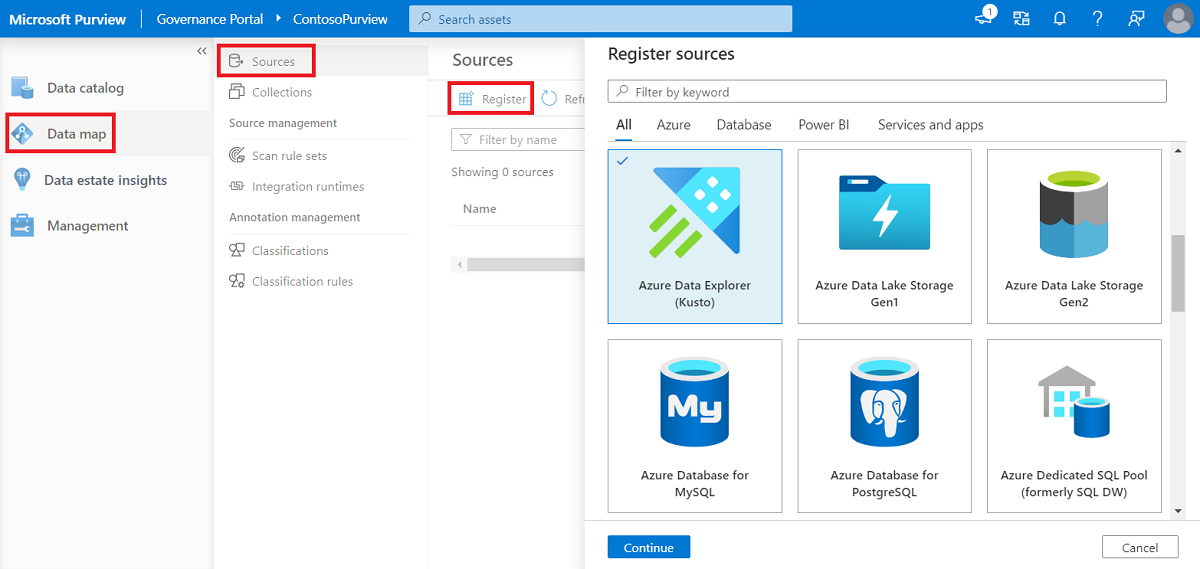
On the Register sources (Azure Data Explorer (Kusto)) screen, do the following:
- Enter a Name that the data source will be listed with in the Catalog.
- Choose your Azure subscription to filter down Azure Data Explorer.
- Select an appropriate cluster.
- Select a collection from the list.
- Select Register to register the data source.
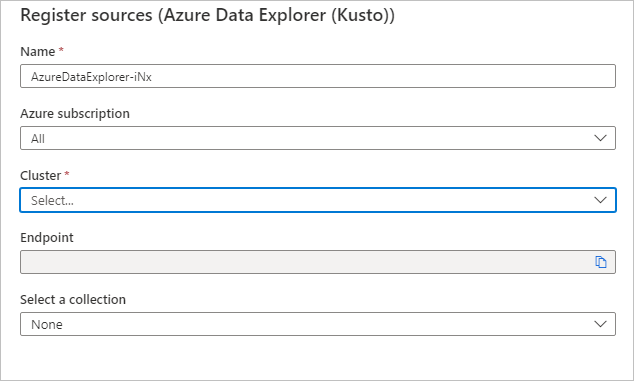
Scan
Follow the steps below to scan Azure Data Explorer to automatically identify assets and classify your data. For more information about scanning in general, see our introduction to scans and ingestion.
Create and run scan
To create and run a new scan, follow these steps:
Select the Data Map tab on the left pane in the Microsoft Purview governance portal.
Select the Azure Data Explorer source that you registered.
Select New scan
Choose either the Azure integration runtime if your source is publicly accessible, a managed virtual network integration runtime if using a managed virtual network, or a self-hosted integration runtime if your source is in a private virtual network. For more information about which integration runtime to use, see the choose the right integration runtime configuration article.
Select the credential to connect to your data source.
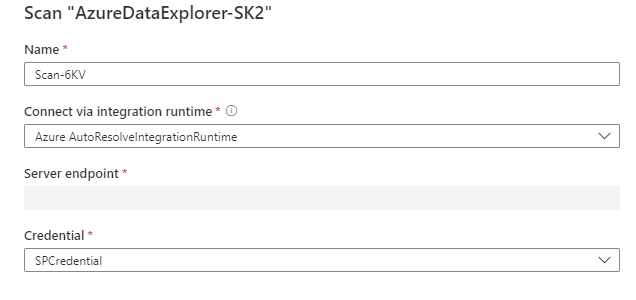
You can scope your scan to specific databases by choosing the appropriate items in the list.
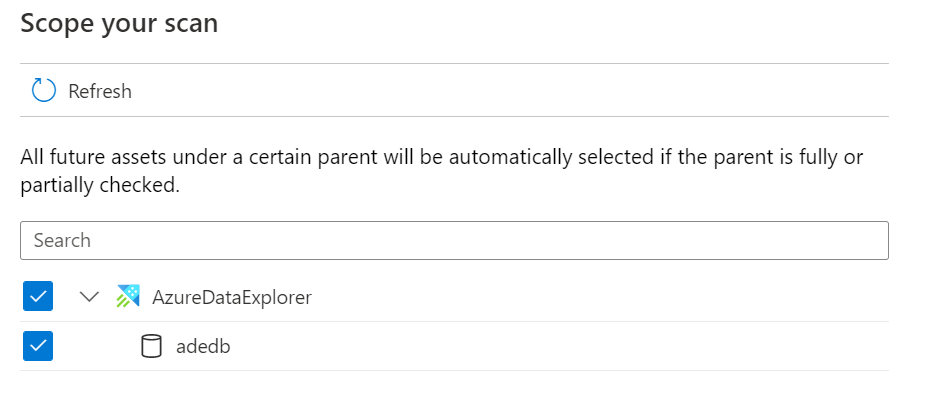
Then select a scan rule set. You can choose between the system default, existing custom rule sets, or create a new rule set inline.

Choose your scan trigger. You can set up a schedule or run the scan once.
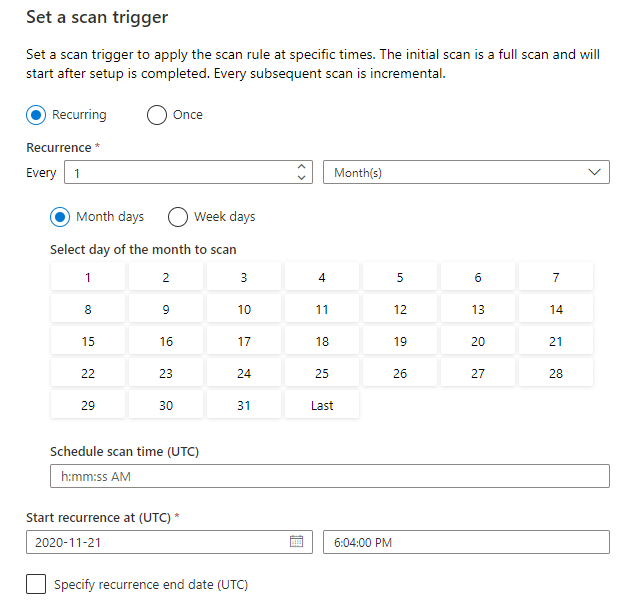
Review your scan and select Save and run.
View your scans and scan runs
To view existing scans:
- Go to the Microsoft Purview portal. On the left pane, select Data map.
- Select the data source. You can view a list of existing scans on that data source under Recent scans, or you can view all scans on the Scans tab.
- Select the scan that has results you want to view. The pane shows you all the previous scan runs, along with the status and metrics for each scan run.
- Select the run ID to check the scan run details.
Manage your scans
To edit, cancel, or delete a scan:
Go to the Microsoft Purview portal. On the left pane, select Data Map.
Select the data source. You can view a list of existing scans on that data source under Recent scans, or you can view all scans on the Scans tab.
Select the scan that you want to manage. You can then:
- Edit the scan by selecting Edit scan.
- Cancel an in-progress scan by selecting Cancel scan run.
- Delete your scan by selecting Delete scan.
Note
- Deleting your scan does not delete catalog assets created from previous scans.
Next steps
Now that you have registered your source, follow the below guides to learn more about Microsoft Purview and your data.
Feedback
Coming soon: Throughout 2024 we will be phasing out GitHub Issues as the feedback mechanism for content and replacing it with a new feedback system. For more information see: https://aka.ms/ContentUserFeedback.
Submit and view feedback for